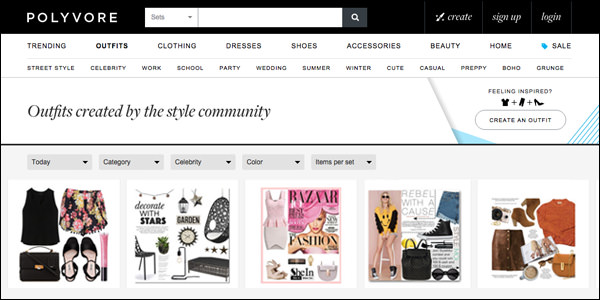
Yahoo buys a social shopping site
Yahoo! Inc. on Friday agreed to acquire Polyvore, a leading social shopping site and specialist in the field of native advertising.
Founded in 2007, Polyvore acts like in a social networking site in enabling users to put together and share "sets" of clothing, accessories and lifestyle goods "that express their love for style and shopping in a compelling, digital, social setting," according to a statement. In contrast to Pinterest, every item can be purchased from a retailer.
"Polyvore’s success has been finding a way to marry the solitary act of online shopping with the social interaction of a shopping trip to the mall, bringing 350 retail partners together with a cadre of fashion-loving stylists and bloggers to offer community-sourced trends, visual outfit boards assembled by other members and tips on mixing and matching items," wrote Adam Tschorn for the Los Angeles Times.
Polyvore earns money through a cost-per-click advertising model. A newish Promoted Products ad feature also lets retailers pay to promote and feature an item on the site’s "What’s Trending" section.
Over 20 million people use the shopping site every month, the most frequent users being 20-something fashionistas.

Source: polyvore.com
Polyvore competes most directly with Wanelo (short for Want Need Love) but a host of other social sites such as Minted, Canopy, Lyst and Svpply also focus on curating and aggregating trends for sale in different ways.
Yahoo will help monetize Polyvore, which will remain a stand-alone platform across the Yahoo network and integrate with Yahoo Gemini, Yahoo’s native advertising network launched with big fanfare last year. Polyvore will strengthen Yahoo’s digital magazines and verticals, such as Yahoo Style and Yahoo Beauty, through the incorporation of community and commerce, and together Yahoo and Polyvore will sell and run native shopping ads that drive traffic and sales to retailers.
Polyvore will also accelerate Yahoo’s Mavens growth strategy (mobile, video, native, social) through its offerings in social, native and mobile. But Yahoo was particularly interested in Polyvore’s native ad technology, which involves advertisements so well-integrated into a platform that they resemble other content.
"Every time we’ve seen an engaged community, we’ve seen magical things happen," Simon Khalaf, Yahoo’s SVP for publisher products, told The New York Times. "This is exactly what we see in Polyvore. Their content is actionable. We were very attracted to this model."
Discussion Questions
Do you see the use of native advertising on sites such as Polyvore as a valuable opportunity for retailers to bring e-commerce to social media? Are there pitfalls to such an approach?


So the term “native advertising” is pretty loaded. I’m not quite sure what it means in the context of Polyvore — that there is a buy button on products you can add to sets? Or that there is advertiser content presented as part of Polyvore’s blogs? That buy button, to me, is far more valuable than anything else. Advertisers and publications have to be careful about native advertising — it’s dangerous territory without a lot of good guidelines on what’s okay and what is being deceptive to readers.
This is certainly one option for merging advertising and social media. I do not understand the term “native advertising.” However a certain percentage of consumers engage in social shopping and this site has been growing. This is not appropriate for all consumers. However, this is the kind of experimentation that is needed and is likely to be part of a consumer solution.
The opportunity is definitely there for native advertising. The sites have to be attractive to the intended audience and the offers have to be compelling. That’s much easier said than done.
From bargain basements, to huge discount standalone stores, to dollar stores to second hand certified land. This is the legacy of our economy and a snapshot of the future?. What we are seeing is the retailer(s) looking to expand into growing markets that they have knowledge of simply to improve profits that are still shrinking year after year.
It may be hard to fathom, but traditional online advertising has matured so fast it has become outdated. The conventional models of display and retargeting are passé, especially for Millennials.
This forces retailers to find models that better engage shoppers. It also forces online publishers to evolve.
Social sites like Instagram and Pinterest and native ad platforms like Buzzfeed are drawing more advertisers and growing. Polyvore allows Yahoo to bolster Gemini, which is already successfully helping publishers buy ads on Yahoo and across the web. This helps turn around Yahoo’s declining ad revenue and boost time on Yahoo-owned properties.
Yahoo and retailers seek native advertising plays like Polyvore not just for opportunity, but out of necessity.